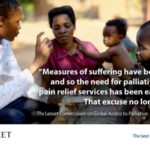
We have very few global landmarks in the evolution of palliative care. So when a new one comes along it is important to take note, to reflect, and to consider the implications. The report of the Lancet Commission on Pain and Palliative Care is such a work.
I was fortunate to be asked to join some 61 co-authors from 25 countries to assist in the Commission, though the bulk of the activity was driven forward by a small group of people who played major roles in the research and writing. I believe they have brought something new to the table that merits serous attention. Let’s first put it in context.
In 1990 the World Health Organization set out the scope and definition of palliative care and began to suggest how these should be pursued as public health issues. Twenty four years later the World Health Assembly, the governing body of WHO, passed a resolution calling on all governments to integrate palliative care across the life course into their strategies and plans, with a particular focus on community interventions. The years in between saw the publication of two world maps of palliative care development, in 2008 and 2013. We have also seen the strengthening of palliative care advocacy organisations such as IAHPC and WHPCA, which now do a great deal to create awareness about and encourage the development of palliative care services around the world. Many countries have palliative care policies, guidelines and strategies. The ‘field’ of palliative care is growing, with more specialist practitioners, training programmes, research and knowledge centres.
If there has been any tendency to self-congratulation over all this, the Commission’s report sweeps it aside in a chilling blast of new data, ambitious recommendations and an emotive call to action.
The report is a stark description of the obdurate problems that remain and the massive injustices that prevail around the world when it comes to pain relief and palliative care. But with that the authors bring new approaches and recommendations. Likewise, if the Commission’s report is lengthy and detailed, nevertheless, passion and a commitment to change leap off every page.
This report does four things:
First, it quantifies (for the first time) the heavy burden worldwide of ‘serious health-related suffering’ that can be ameliorated by palliative care and pain relief.
Second, it describes and gives costings for an ‘essential package’ of palliative care and pain relief health services that might alleviate that burden.
Third, it emphasises the inequitable access and unfair costing of ‘off patent’ oral and injectable morphine and what it would cost to make this key drug adequately and fairly available in all countries.
Fourth, it advocates strongly that access to pain relief and palliative care should become a part of Universal Health Coverage in all countries – requiring strategies at the national and global level.
In 2015, an estimated 25.5 million people died with serious health related suffering – equivalent to nearly half of all deaths worldwide. This includes 2.5 million children aged under 15 years. In addition, another 35.5 million people experienced serious health-related suffering, but did not die.
The Commission therefore produces a devastating new metric. The total number of people needing palliative care per year is over 61 million, including 5.3 million children. That’s equivalent to the entire population of Italy. Yet more than 80% of those people needing palliative care are found not in situations of affluence, but in low and middle-income countries.
We know already that most palliative care capital and resources are concentrated in the rich countries. But where the need for palliative care is greatest, the level of provision, if it exists at all, is often patchy and quite incommensurate with what is required by way of response. In his comment on the report, Lancet editor Richard Horton puts it unambiguously: ‘The Commission has uncovered an appalling oversight in global health. It is time for that oversight to be remedied’.
My sense is that we have gone to a different level with the Commission’s report. Its analysis is compelling. It will rally support and engagement. It rightly calls for more and better research to support its implementation. In the coming weeks and months we will see how other communities of interest respond, particularly palliative care specialists. The report is not only a manifesto for action, it is also a strategic intervention that will no doubt provoke wider debate and commentary.

